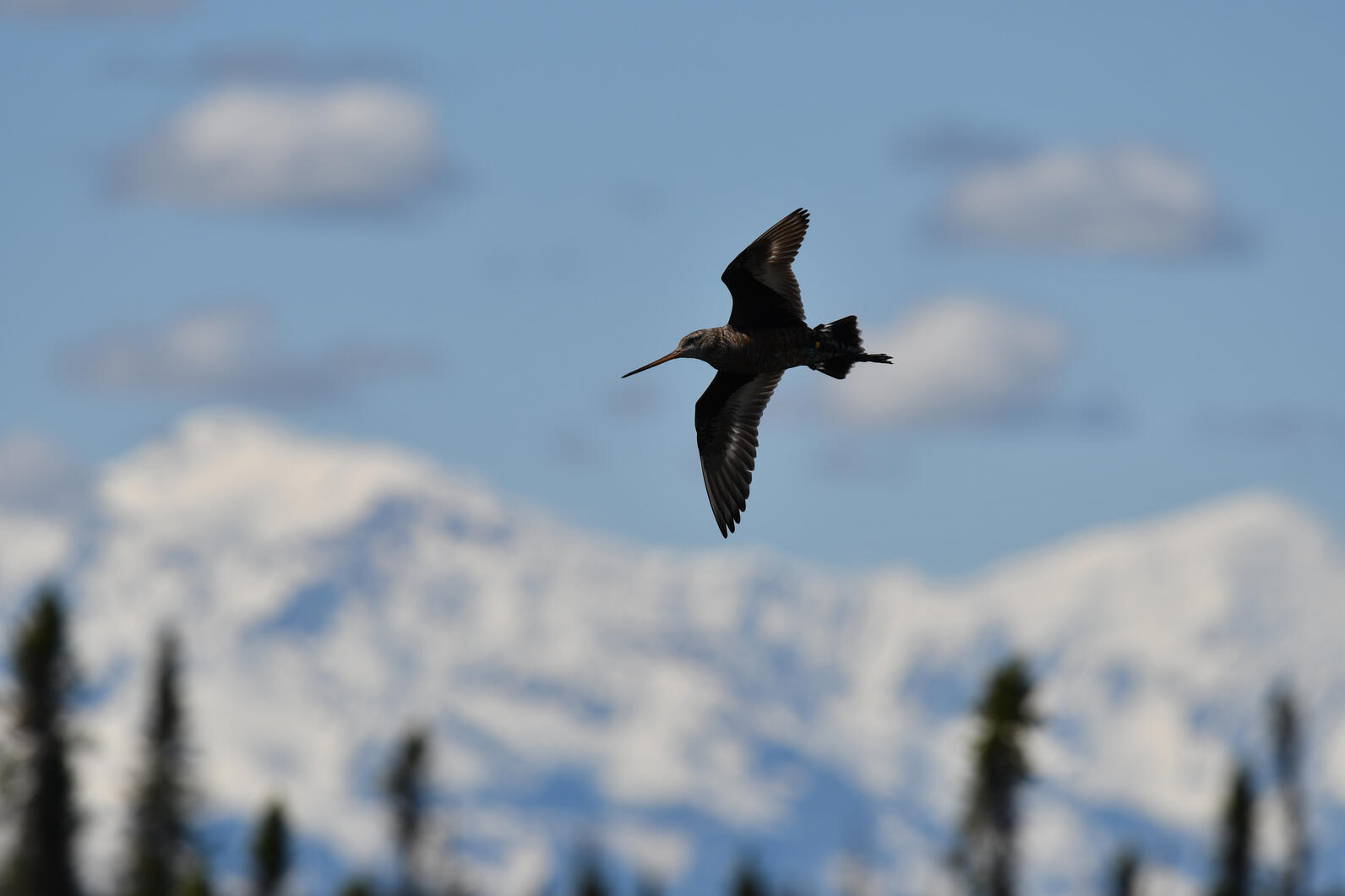Alaska’s Department of Transportation and Public Facilities (DOT&PF) recently proposed the development of a 15-mile paved, public road—the West Susitna Access Road—under the Statewide Transportation Improvement Program (STIP). This road would connect greater Anchorage and Wasilla to west of the Susitna River, providing Alaskan residents and visitors with increased accessibility to recreational activities in an area that has remained undeveloped and uncharted by many.
But it’s not just people who want greater access to this beautiful landscape. Traveling by the thousands, and sometimes upwards of 10,000 miles to get there, migratory shorebirds also inhabit and breed in the areas west of the Susitna River. For a glimpse, let’s zoom in on just one site west of the Susitna River on the Upper Cook Inlet—Beluga. Here, Short-billed Dowitchers, Greater and Lesser Yellowlegs, Least Sandpipers, and Hudsonian Godwits are just a few of the species that can be found breeding there during the summer months. But, why Beluga?
Each shorebird species relies on specialized habitats to successfully raise their young. In Beluga, that habitat for most shorebird species is muskeg bog. Muskeg bog is primarily made up of black spruce trees, moss, and water, each of which is intertwined in a mosaic-like fashion across the landscape. For shorebirds in the bog, nesting between these small, interconnected water bodies helps protect eggs and chicks from predators. Muskeg bog is also a highly acidic environment that grows a suite of particular plants that are important for nesting. Found in abundance, bits of white reindeer moss, for instance, perfectly match the marbled chick down of many shorebird species, providing unparalleled camouflage and protection.
Additionally, intertidal mudflats—best described as beaches of incredibly thick clay-like mud—line the coast of the Upper Cook Inlet adjacent to Beluga and ephemerally appear with fluctuating tides. And, while seemingly lifeless on the surface, deep in the mud, they support a buffet of invertebrates for adult shorebirds, exactly what they need after a long migratory flight or day spent incubating. Equally important, this region remains relatively undeveloped and remote. Under the stewardship of the Dena’ina peoples, it is only accessible by plane or barge, leaving the birds with minimal disturbance—as of right now.

With a budget of around $82 million, the West Susitna Access Road project will not only result in a connection to a contiguous highway but also a boat ramp and bridge across the Susitna River. Roughly 20 miles north of Beluga, the bridge is planned to be constructed right below the merging of the Yentna and Susitna Rivers, which flow directly into Upper Cook Inlet. Aside from the obvious immediate impacts—resulting from the construction of the road and accompanying infrastructure—it remains hard to predict what changes shorebirds breeding in Beluga and surrounding areas might experience in the coming years as a result of this massive urbanization project.
Perhaps the most likely impacts are that subsequent recreational visitors will increase anthropogenic disturbance, while construction will disrupt the landscape in other, unprecedented, ways. Both disturbance and habitat modification are almost always associated with negative downstream ecological impacts. For example, the Beluga Highway is an existing, unpaved road in the Beluga area that is not connected to the rest of the Alaskan road system. Used by homesteaders and power plant workers alike, it divides portions of the once-connected, muskeg bog. With the natural hydrology disrupted, portions of the bog that are now disconnected from the surrounding landscape have dried and consequently become less suitable for shorebirds.
Access to plentiful, suitable habitat, though, is key for the persistence of shorebird species. Globally, migratory shorebirds are rapidly declining at alarming rates and habitat degradation and loss are known to be contributing factors. Therefore, despite future disturbance and habitat modification associated with the West Susitna Access Road being localized, the effects will likely amplify threats that shorebirds are facing elsewhere—making the subsequent impacts on shorebird species breeding in that area far-reaching.
Moreover, the West Susitna Access Road will brush up against Susitna Flats, a State Game Refuge overseen by the Alaska Department of Fish and Game, that is principally protected because of the incredible number of migrating waterfowl and shorebirds that use this area in late spring and summer every year.

A 15-mile road may seem trivial, but many are concerned that this is only the beginning. In addition to Alaska’s Department of Transportation and Public Facilities (DOT&PF) plan for the West Susitna Access Road, the Alaska Industrial Development and Export Authority (AIDEA) has been pursuing the West Susitna Access Project—a 100-mile service road to expand mining, oil, gas, and agriculture in the West Susitna area.
Despite AIDEA publicly stating that their project is not connected to the proposed public West Susitna Access Road, it is clear that they still plan to explore the area west of the Susitna River in hopes of future industrial development. Therefore, building the West Susitna Access Road could pave the way—literally and figuratively—for additional infrastructure in the region. The environmental and ecological impacts of such massive development in the Susitna watershed are unknown, but unlikely to be positive.
While the opportunity to publicly comment on the 2024-2027 Statewide Transportation Improvement Program (STIP) draft just closed in early September, concerned members of the public can still send in comments on the project via email (dot.stip@alaska.gov). Pending approval and consideration of public comment, construction could begin as early as 2025.
—Lauren Puleo is an ECO MSc Student at the University of Massachusetts Amherst Senner Lab.








